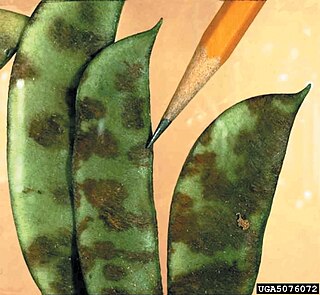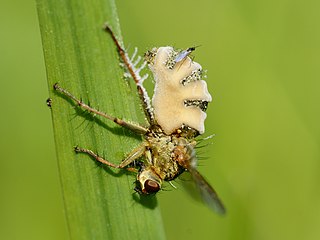Related Research Articles

A vacuole is a membrane-bound organelle which is present in plant and fungal cells and some protist, animal, and bacterial cells. Vacuoles are essentially enclosed compartments which are filled with water containing inorganic and organic molecules including enzymes in solution, though in certain cases they may contain solids which have been engulfed. Vacuoles are formed by the fusion of multiple membrane vesicles and are effectively just larger forms of these. The organelle has no basic shape or size; its structure varies according to the requirements of the cell.

A hypha is a long, branching filamentous structure of a fungus, oomycete, or actinobacterium. In most fungi, hyphae are the main mode of vegetative growth, and are collectively called a mycelium.

A sporangium is an enclosure in which spores are formed. It can be composed of a single cell or can be multicellular. All plants, fungi, and many other lineages form sporangia at some point in their life cycle. Sporangia can produce spores by mitosis, but in nearly all land plants and many fungi, sporangia are the site of meiosis and produce genetically distinct haploid spores.sporangia (singular-sporangium)

Zygomycota, or zygote fungi, is a former division or phylum of the kingdom Fungi. The members are now part of two phyla the Mucoromycota and Zoopagomycota. Approximately 1060 species are known. They are mostly terrestrial in habitat, living in soil or on decaying plant or animal material. Some are parasites of plants, insects, and small animals, while others form symbiotic relationships with plants. Zygomycete hyphae may be coenocytic, forming septa only where gametes are formed or to wall off dead hyphae. Zygomycota is no longer recognised as it was not believed to be truly monophyletic.

Pilobolus is a genus of fungi that commonly grows on herbivore dung.
A zygospore is a diploid reproductive stage in the life cycle of many fungi and protists. Zygospores are created by the nuclear fusion of haploid cells. In fungi, zygospores are formed in zygosporangia after the fusion of specialized budding structures, from mycelia of the same or different mating types, and may be chlamydospores. In many eukaryotic algae, including many species of the Chlorophyta, zygospores are formed by the fusion of unicellular gametes of different mating types.
Vesicle may refer to:

An appressorium is a specialized cell typical of many fungal plant pathogens that is used to infect host plants. It is a flattened, hyphal "pressing" organ, from which a minute infection peg grows and enters the host, using turgor pressure capable of punching through even Mylar.
Turgor pressure is the force within the cell that pushes the plasma membrane against the cell wall.

Synchytrium endobioticum is a chytrid fungus that causes the potato wart disease, or black scab. It also infects some other plants of the genus Solanum, though potato is the only cultivated host.

The Mucorales is the largest and best studied order of zygomycete fungi. Members of this order are sometimes called pin molds. The term mucormycosis is now preferred for infections caused by molds belonging to the order Mucorales.

Albugo candida, commonly known as white rust, is a species of oomycete in the family Albuginaceae. It is sometimes called a fungus, but in fact forms part of a distinct lineage of fungus-like microorganisms, Oomycetes, commonly known as water moulds. A. candida is an obligate plant pathogen that infects Brassicaceae species and causes the disease known as white rust or white blister rust. It has a relatively smaller genome than other oomycetes.

Colletotrichum lindemuthianum is a fungus which causes anthracnose, or black spot disease, of the common bean plant. It is considered a hemibiotrophic pathogen because it spends part of its infection cycle as a biotroph, living off of the host but not harming it, and the other part as a necrotroph, killing and obtaining nutrients from the host tissues.

Pilobolus crystallinus var. crystallinus, commonly known as the "Dung Cannon" or "Hat Thrower", is a species of fungus belonging to the Mucorales order. It is unique in that it adheres its spores to vegetation, so as to be eaten by grazing animals. It then passes through the animals' digestive systems and grows in their feces. Although these fungi only grow to be 2–4 cm (0.8–1.6 in) tall, they can shoot their sporangium, containing their spores, up to 2 m (6.6 ft) away. Due to an increase of pressure in the vesicle, the sporangium can accelerate 0–45 mph in the first millimeter of its flight, which corresponds to an acceleration of an incredible 20000 g. Using a mucus-like substance found in the vesicle of the fungus, the sporangium can adhere itself onto whatever it lands, thus completing its life cycle.

Entomophthora is a fungal genus in the family Entomophthoraceae. Species in this genus are parasitic on flies and other two-winged insects. The genus was circumscribed by German biologist Ferdinand Cohn in 1856.

The Pilobolaceae are a family of fungi in the Mucorales order. Generally, species in this family have a widespread distribution, although there are some that are restricted to tropical and subtropical regions. This family includes two genera: Pilobolus, and Utharomyces.
Rastrimonas is a monotypic genus of parasitic alveolates in the phylum Apicomplexa. It contains the single species Rastrimonas subtilis. It was described in 2002 from the free-living cryptomonad Chilomonas paramaecium and placed in the new genus Cryptophagus. The following year this was renamed Rastrimonas.
An annulus in botany is an arc or a ring of specialized cells on the sporangium. These cells are arranged in a single row, and are associated with the release or dispersal of spores.
Parvilucifera is a genus of marine alveolates that parasitise dinoflagellates. Parvilucifera is a parasitic genus described in 1999 by Norén et al. It is classified perkinsozoa in the supraphylum of Alveolates. This taxon serves as a sister taxon to the dinoflagellates and apicomplexans. Thus far, five species have been described in this taxon, which include: P.infectans, P.sinerae, P.corolla, P.rostrata, and P.prorocentri. The genus Parvilucifera is morphologically characterized by flagellated zoospore. The life cycle of the species in this genus consist of free-living zoospores, an intracellular stage called trophont, and asexual division to form resting sporangium inside host cell. This taxon has gained more interest in research due to its potential significance in terms of negative regulation for dinoflagellates blooms, that have proved harmful for algal species, humans, and the shellfish industry.

Scytothamnus australis is a brown alga species in the genus Scytothamnus found in New Zealand. It is a sulphated polysaccharide and the type species in the genus.
References
- C.J. Alexopolous, Charles W. Mims, M. Blackwell et al., Introductory Mycology, 4th ed. (John Wiley and Sons, Hoboken NJ, 2004) ISBN 0-471-52229-5